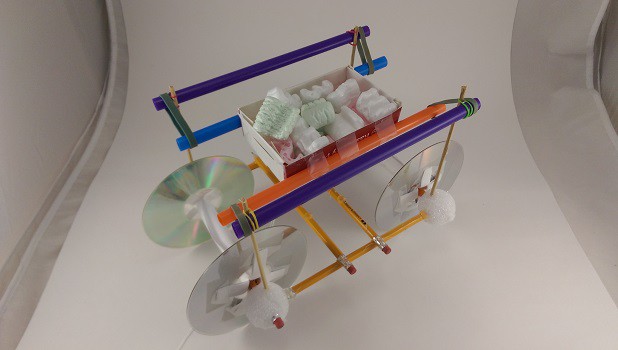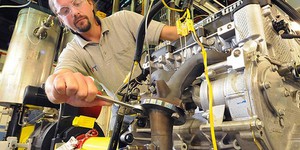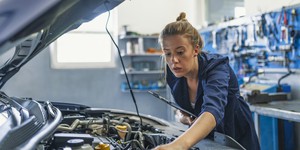Absorb the Shock!
Summary
This project was inspired by the Trash Sliders activity by Larry Richards

Introduction
Have you ever ridden in a car over a pothole or a speed bump? You might feel the bumps and get tossed up and down in your seat a little bit, but not nearly as much as you would if the car did not have a suspension. Try this engineering project to learn how a suspension helps give you a smoother ride!
Background
You might not give it much thought if you are riding down a smooth, nicely paved road, but a car’s suspension is very important when driving on a bumpy road or over obstacles. It helps protect the car (and the passengers!) from damage when the car goes over a big bump. A car’s frame (and the seats inside it) is not rigidly connected to the wheels. If it was, every single bump or vibration experienced by the wheels would be transferred directly to the car and the people inside it – making for quite an uncomfortable ride. Instead, the wheels are connected to the rest of the car with a combination of springs (metal parts that bounce back to their original position when stretched or compressed) and dampers (parts that use friction to slow down motion, usually in the form of a piston filled with viscous oil), also called shock absorbers. Combined, these parts help absorb and decrease the vibrations from the road. In this project you will build your own simple model car and design a suspension to help prevent the cargo (packing peanuts) from being tossed out of the car when it drives over bumps!
Materials
This is an engineering design project, meaning there is not an exact list of materials that you must use. The following list is a suggestion, but feel free to substitute other materials.
- Office and craft materials to build a simple car. Search online for “balloon powered car” or “rubber band car” and you will find many design ideas. In general, you will need:
- Something to use as the car’s wheels, like CDs or plastic bottle caps
- Something to use as axles, like wooden skewers or pencils
- Something to use as the car’s frame, like a plastic bottle, cardboard tube, or straws
- Glue or tape to attach the different parts together
- Alternatively, if you do not want to build your own car from scratch, you could use a medium-sized toy car
- Small cardboard box that will fit on your car
- Packing peanuts
- String
- Assorted rubber bands and/or small springs (you can get springs by disassembling ballpoint pens)
- Straws or pencils
- Tape
- Scissors
Instructions
Remember that this is an engineering design project – there is no single “correct” way to do it. The procedure below is a suggestion, but you can modify it at any point depending on what materials you decide to use.
- Assemble the body of your car (skip this step if you are using a toy car).
- Assemble the axles so they can rotate – for example, thread wooden skewers through straws.
- Attach wheels to the axles. For example, poke holes in the center of plastic bottle caps, then poke wooden skewers through the holes.
- Build a frame for the car and attach the wheels and axles. Make sure the axles can rotate freely and do not have too much friction.
- Tie a string to the front of your car so you can easily pull it along.
- Cut the flaps off your small cardboard box so the top of it is open.
- Attach the box to the top of your car and fill it to the brim with packing peanuts.
- Set up “speed bumps” for your car to drive over. For example, tape several straws or pencils to a tabletop, parallel to each other and a few inches apart.
- Pull the car quickly across the speed bumps. What happens?
- Now, try to design a suspension for your car to prevent the packing peanuts from falling out of the box (don’t cheat by putting a lid on the box – leave the top of the box open). For example, as shown in the illustration, you could suspend the cardboard box from rubber bands. This is where the engineering design process really comes in to play!
- Once you have built your suspension, try pulling your car over the speed bumps again. What happens this time? Do fewer packing peanuts fall out?
- Don’t get discouraged if your suspension doesn’t work on the first try! The engineering design process is iterative, meaning engineers often go back and re-design, re-build, and re-test their devices to improve them. There are many different things you can tweak about your design. For example:
- Try changing the type of rubber bands. What happens if you use thicker or thinner rubber bands, or longer or shorter ones?
- Try changing the tightness of the rubber bands. What happens if the box is hanging from them loosely or if the rubber bands are pulled tight?
- Try changing the weight of different parts of the car (weight has a big impact on vibrations). For example, what happens if you tape a bunch of coins to the cardboard box to make it heavier? What happens if you tape the coins to the frame of the car instead?
- Keep iterating and tweaking your design. Can you get to a point where no packing peanuts fall out of the box?
Observations and Results
You should find that when you attach the cardboard box directly to the frame of your car, many of the packing peanuts are tossed out of the box when you pull it over the speed bumps. This occurs because the vibrations from the wheels are transferred directly to the cardboard box. This would be like riding in a car with no suspension – quite an uncomfortable ride (although of course, in a real car you would be wearing a seat belt, so you would not be tossed out of the car)! When you add a suspension, it helps absorb some of the vibrations, so the cardboard box does not bounce up and down as much, and doesn’t toss out as many of the packing peanuts. However, it may take some tweaking to get your suspension working well. The stiffness (thickness/length/tightness of the rubber bands or springs) and weight of an object (for example, adding coins) have a big impact on how it reacts to vibrations. Real engineers carefully design a car’s suspension to optimally absorb vibrations on the road, just like you did in this project!
Ask an Expert
Additional Resources
- Balloon-Powered Car Challenge, by Science Buddies
- Science Activities for All Ages!, from Science Buddies







